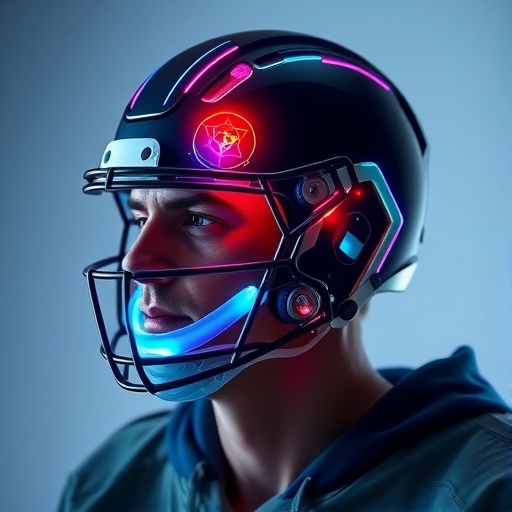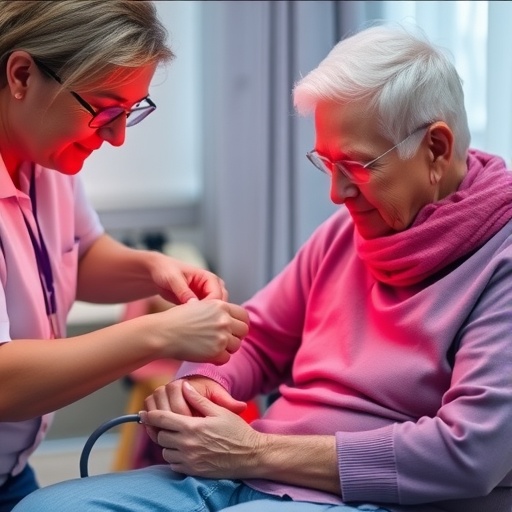In the rapidly evolving field of biomechanics, understanding the intricacies of head acceleration is paramount, especially for athletes involved in contact sports. A groundbreaking study led by researchers including Luke, Masood, and Bondi addresses a critical aspect of head injury prevention: effectively measuring head acceleration exposure using instrumented mouthguards. As sports science increasingly leans on advanced technology to safeguard athletes, this research pushes the boundaries of our knowledge and implementation strategies in injury prevention.
Head injuries, particularly concussions, pose significant risks in athletic environments. These injuries can lead to long-term health complications, not only affecting an athlete’s career but also their quality of life. This predicament has spurred researchers to seek reliable methods for monitoring head impacts and exposure to acceleration forces. The study by Luke et al. aims to fill a vital gap in the existing literature by focusing on the measurement of head acceleration during actual on-field conditions, thus providing insights that laboratory settings cannot replicate.
Instrumented mouthguards represent a significant advancement in the collection of precise biomechanical data. These innovative devices are equipped with sensors that measure accelerative forces directly as athletes engage in their respective sports. Unlike traditional approaches that rely on retrospective self-reporting or video analysis, instrumented mouthguards provide real-time data on every impact the athlete experiences, enabling a comprehensive understanding of exposure levels and potential risks of head injuries.
While the data collected by these mouthguards is invaluable, it is not without its challenges. One of the prominent issues researchers face is dealing with missing data. Various factors including sensor errors, athlete non-compliance, and device malfunctions can lead to incomplete datasets that hinder the validity of the findings. The study addresses these challenges head-on, proposing innovative missing data imputation techniques. By employing advanced statistical methods, the researchers aim to ensure a robust analysis that compensates for absent values, thereby providing a complete picture of head acceleration exposure.
The implications of this research extend beyond mere data collection. It emphasizes the importance of a proactive approach in understanding exposure to head impacts in athletes. By incorporating real-time data analysis into performance and health monitoring strategies, coaches and sports organizations can make informed decisions that prioritize athlete safety. This technological integration can potentially transform training and competitive practices by allowing for tailored preventative measures based on individual exposure levels.
By providing a comprehensive analysis of head acceleration exposure, this research not only contributes to the existing body of knowledge but also lays the groundwork for further studies in biomechanics and injury prevention. The findings could pave the way for new guidelines and best practices in sports training, particularly in collision-heavy sports such as football, rugby, and ice hockey.
Moreover, the study is a clarion call for increased awareness and understanding of head injuries among athletes, coaches, and parents. With heightened visibility around concussion protocols and athlete welfare, there is a pressing need for everyone involved in sports to be educated about the dangers of head impacts. The integration of this technology into training regimens not only underscores the importance of safety but also cultivates a culture of accountability and care.
Looking towards the future, the researchers advocate for continued innovation in the development of instrumented mouthguards and similar technologies. As we advance, the potential for integrating machine learning and artificial intelligence into these devices increases, promising even greater accuracy in data collection and analysis. By harnessing these technological advancements, we can continue to refine our methods for tracking head injury risks and ultimately protect athletes more effectively.
This research underlines a critical paradigm shift in the way we approach head injuries in athletics. Rather than relegating the conversation to post-injury assessments, the proactive measurement of head acceleration and ongoing data analysis will allow sports organizations to fundamentally change how they protect their athletes. The incorporation of real-time data through instrumented mouthguards is a monumental step forward, illustrating the power of technology in enhancing athlete safety.
As the urgency surrounding head injuries continues to grow, studies like that of Luke et al. play a vital role in advancing our understanding and response strategies. The research advocates for a unified effort across sports organizations, researchers, and technology developers to prioritize and innovate in the realm of athlete safety. Moving forward, this collaborative approach may well be the key to mitigating the risks associated with head injuries and ensuring that athletes can enjoy their sports without compromising their health.
In summary, the work by Luke and colleagues is a significant contribution to the field of sports science, particularly in relation to head acceleration exposure measurement. Their emphasis on addressing missing data through innovative techniques showcases the adaptability of research in response to the challenges of data collection. This study not only reinforces the importance of continuous monitoring for athlete safety but also encourages a more informed approach to training and injury prevention in contact sports.
As we digest the findings of this important research, it’s clear that the onus lies not just with the athletes but with the entire sports community to champion safety measures and innovate continuously to protect those who dedicate their lives to sport. The use of instrumented mouthguards and the advanced methods outlined in this study could be the stepping stones necessary for a future where athlete safety and performance go hand in hand without compromise.
Strongly advocating for the adoption of new technologies in sports, Luke et al. provide a template for future research ambitions grounded in practical applicability and real-world insights. As we continue to unravel the complexities of head injuries and their repercussions, public understanding, combined with scientific exploration, will be vital in fostering a healthier, safer environment for all athletes.
Ultimately, the vision of a safe sporting environment is not just a personal goal for each athlete; it is a collective objective that requires collaborative efforts across all levels of sports. By embracing the advancements highlighted in this research, we take significant strides toward achieving that vision for future generations of athletes who will sport their helmets, pads, and mouthguards with pride, knowing their safety is being prioritized.
Subject of Research: Measurement of head acceleration exposure in contact sports using instrumented mouthguards.
Article Title: Publisher Correction: On-field Head Acceleration Exposure Measurement Using Instrumented Mouthguards: Missing Data Imputation for Complete Exposure Analysis.
Article References:
Luke, D., Masood, Z., Bondi, D. et al. Publisher Correction: On-field Head Acceleration Exposure Measurement Using Instrumented Mouthguards: Missing Data Imputation for Complete Exposure Analysis.
Ann Biomed Eng (2025). https://doi.org/10.1007/s10439-025-03893-x
Image Credits: AI Generated
DOI: 10.1007/s10439-025-03893-x
Keywords: instrumented mouthguards, head acceleration, injury prevention, concussion, biomechanics, athlete safety, real-time data analysis, missing data imputation.
Tags: advanced sports science researchathlete safety innovationsbiomechanics of head accelerationconcussion risk in athletescontact sports injury preventionhead injury preventioninstrumented mouthguards technologylong-term health effects of concussionsmeasuring head impacts in sportsmonitoring head acceleration exposurereal-time data collection in sportsresearch in sports biomechanics





